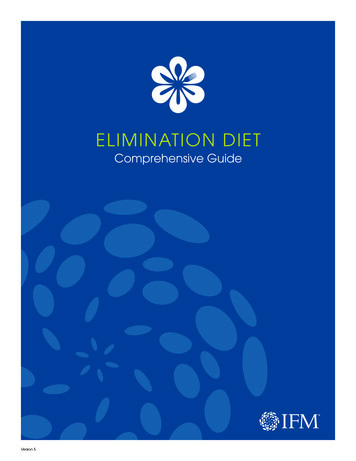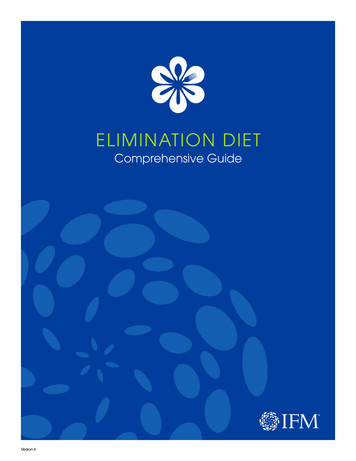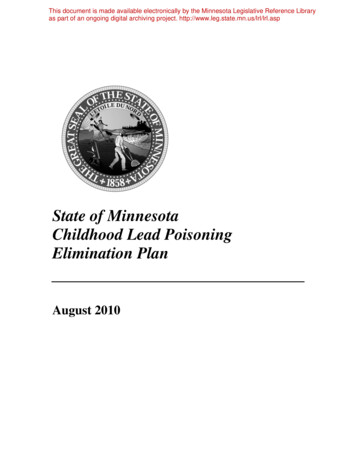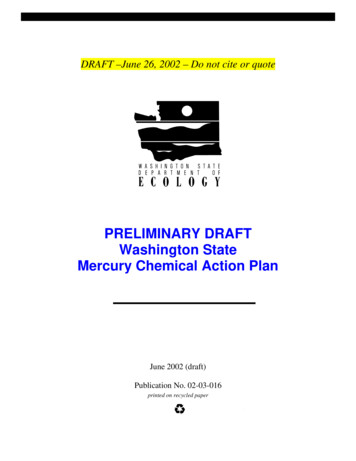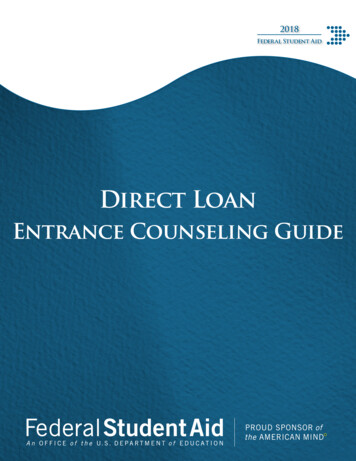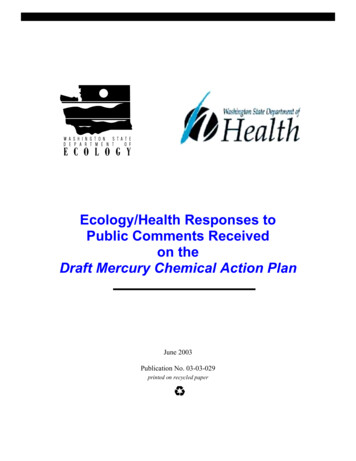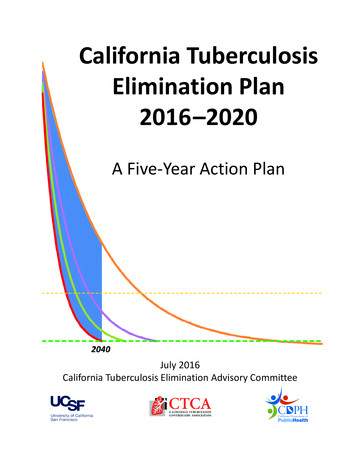
Transcription
California TuberculosisElimination Plan2016 –2020A Five-Year Action PlanJuly 2016California Tuberculosis Elimination Advisory Committee
California TuberculosisElimination Plan2016–2020A Five-Year Action PlanJuly 2016California Tuberculosis Elimination Advisory Committee
iiCalifornia Tuberculosis Elimination Plan, 2016 – 2020
PrefaceAcknowledgementsThe authors of this report thank the participants of the day-long meeting held inOakland, California on December 9, 2015, during which the framework for thisplan was developed. Special recognition and thanks go to Kay Wallis for facilitating the meeting.This plan was supported by the California HealthCare Foundation grant number18422, Centers for Disease Control and Prevention Cooperative Agreement Number U52-PS004656 and the California Department of Public Health TuberculosisControl Branch.CopyrightAll material contained in this report is in the public domain and may be used andreprinted without permission; citation to source, however, is appreciated.Suggested citationCalifornia Tuberculosis Elimination Advisory Committee. California TuberculosisElimination Plan 2016-2020. Richmond, CA. July 2016.DisclaimerThis report was made possible by a grant from the California HealthCare Foundation. The authors are solely responsible for its content and the opinions expresseddo not necessarily represent the views of the California HealthCare Foundation.This report was supported by Cooperative Agreement Number U52-PS004656,funded by the U.S. Centers for Disease Control and Prevention. Its contents aresolely the responsibility of the authors and do not necessarily represent the official views of the U.S. Centers for Disease Control and Prevention or the U.S.Department of Health and Human Services.iii
ivCalifornia Tuberculosis Elimination Plan, 2016 – 2020
Table of ContentsCTEAC Members and StakeholdersI.Executive SummaryII.Backgroundvii111III. How to Use this Plan15IV. Tuberculosis Epidemiology, Control and Preventionin California17V.Action Steps for the Interventions to EliminateTuberculosisVI. Partners Needed for Tuberculosis Elimination2543VII. Resources Needed to Reach Tuberculosis Elimination 47VIII. Implementation and Evaluation Plan51IX. Implementation Timeline53X.61Next Steps for Plan ImplementationXI. How to Support this Plan63XII. References67XIII. Appendices69Appendix A: Glossary of Terms69Appendix B: California Tuberculosis Elimination TaskForce Report71v
viCalifornia Tuberculosis Elimination Plan, 2016 – 2020
CTEAC Members andStakeholdersCTEAC MembersGil F. Chavez, MD, MPHCTEAC Co-ChairState Epidemiologist, Deputy DirectorCenter for Infectious DiseasesCalifornia Department ofPublic HealthSacramento, CaliforniaGeorge Rutherford, MDCTEAC Co-ChairSalvatore Pablo Lucia Professor ofEpidemiology, Preventive Medicine,Pediatrics and HistoryVice Chair, Dept. of Epidemiology andBiostatisticsHead, Division of Infectious DiseaseEpidemiologyUniversity of California, San FranciscoSan Francisco, CaliforniaJennifer Arnold, MDChair, Infection Control CommitteeKaiser Permanente, OaklandOakland, CaliforniaMichael Carson, MSTB Program ManagerTB Control and Refugee HealthServicesOrange County Health Care AgencySanta Ana, CaliforniaBarbara Cole, RN, PHN, MSNChief, Disease Control BranchRiverside County Department ofPublic HealthRiverside, CaliforniaJulie Higashi, MD, PhDDirector, TB Control SectionSan Francisco Department ofPublic HealthSan Francisco, CaliforniaSandra Huang, MD, MPHTB ControllerAlameda County Public HealthDepartmentSan Leandro, CaliforniaBrenda Elaine Jones, MDAssociate Professor, Clinical MedicineKeck School of MedicineUniversity of Southern CaliforniaLos Angeles, CaliforniaOlivia Kasirye, MD, MSTB ControllerSacramento County Division of PublicHealthSacramento, CaliforniaApril King-Todd, RN, BSN, MPHNurse ManagerTB Control ProgramLos Angeles County Department ofPublic HealthLos Angeles, CaliforniaBrian Lee, MDDirector, Division of InfectiousDiseasesAntimicrobial Stewardship ProgramUCSF Benioff Children’s HospitalOakland, Californiavii
Krystal Liang, PHNPublic Health Nursing SupervisorCounty of San Diego Public HealthServicesSan Diego, CaliforniaKathleen Moser, MD, MPHTB ControllerSan Diego County Health & HumanServices AgencySan Diego, CaliforniaChristine Perez, RN, BSNTB Program CoordinatorHealth Services DepartmentTulare County Health & HumanServices AgencyVisalia, CaliforniaGisela Schecter, MD, MPHPhysician ConsultantTB Control BranchCalifornia Department ofPublic HealthRichmond, CaliforniaJulie Vaishampayan, MD, MPHCalifornia Tuberculosis ControllersAssociation President-electTB ControllerSan Joaquin County Public HealthServicesStockton, CaliforniaStakeholdersFrancisco Aguirre, MDChief Medical OfficerWellSpace HealthSacramento, CaliforniaJeannette Aldous, MDClinical Director of Infectious DiseaseSan Ysidro Health CenterSan Diego, CaliforniaBrian Baker, MDCenters for Disease Control andPrevention Medical OfficerLos Angeles Community HealthServicesLos Angeles, CaliforniaLisa Chen, MDMedical DirectorCurry International TB CenterOakland, CaliforniaGina Fleming, MD, MSPHMedical Director, UC HealthUniversity of California Office of thePresidentOakland, CaliforniaviiiCalifornia Tuberculosis Elimination Plan, 2016 – 2020Nicole Green, PhDLaboratory DirectorLos Angeles County Public HealthLaboratoryLos Angeles, CaliforniaBeverly JacobTB Patient RepresentativeStockton, CaliforniaJerry Jew, MDAssociate Medical DirectorNorth East Medical ServicesSan Francisco, CaliforniaAri Kriegsman, MDInternal MedicineValley Homeless Healthcare ProgramSanta Clara, CaliforniaMaxine Liggins, MD, MPHArea Medical DirectorLos Angeles County Department ofPublic HealthLos Angeles, California
Philip LoBue, MD, FACP, FCCPDirector, Division of TuberculosisEliminationCenters for Disease Control andPreventionAtlanta, GeorgiaJulia Logan, MD, MPHChief Quality OfficerOffice of the Medical DirectorCalifornia Department of Health CareServicesSacramento, CaliforniaGeorge Ma, MDPresidentChinese American MedicalAssociation of Southern CaliforniaLos Angeles, CaliforniaJanet Mohle-Boetani, MD, MPHDeputy Medical ExecutivePublic Health BranchCalifornia Correctional Health CareServicesSacramento, CaliforniaJayant V. Rajan, MD, MAAssistant ProfessorUniversity of California, San FranciscoSan Francisco General HospitalSan Francisco, CaliforniaRandall E. Reves, MD, MScChair ElectStop TB USAProfessor, Department of Medicineand Preventive Medicine andBiometricsUniversity of Colorado School ofMedicineDenver, ColoradoJames SederbergDeputy DirectorCurry International TB CenterOakland, CaliforniaJulie Sierra, MDMedical DirectorInternal Medicine ClinicSan Ysidro Health CenterSan Diego, CaliforniaJosé Antonio Sulca Vera, MDRegulatory Medical SupervisorMexico National TB Prevention andControl ProgramMexico City, MexicoJudith Thigpen, MPHExecutive AdministratorCalifornia Tuberculosis ControllersAssociationSan Francisco, CaliforniaKristin Walsh, MDAdult Custody ServicesSanta Clara Valley Hospital and HealthSystemSan Jose, CaliforniaJames Watt, MD, MPHChief, Division of CommunicableDisease ControlCalifornia Department ofPublic HealthRichmond, CaliforniaDonna Hope Wegener, MSExecutive DirectorNational Tuberculosis ControllersAssociationAtlanta, Georgiaix
xCalifornia Tuberculosis Elimination Plan, 2016 – 2020
I. Executive SummaryCalifornia has had a steady decline in tuberculosis (TB) disease, but this trend hasslowed significantly since 2000 and appears to have slowed further since 2013.Public health departments have been successful in curtailing transmission of TBin California, and now most new TB cases in California result from longstandinglatent TB infection (LTBI) that, in many persons, progresses to active TB disease.There are an estimated 2.4 million persons with LTBI in California. This reservoirof TB infection must be addressed to achieve a further reduction in TB disease.Several advances make it timely to pursue elimination of TB1 in California: a newshort-course drug regimen for LTBI with very high treatment completion rates;the interferon-gamma release assay blood tests now available have fewer falsepositive results in foreign-born persons; the Affordable Care Act has expandedaccess to health care; national and international organizations are now focusedon elimination and LTBI prevention; and the U.S. Preventive Services Task Forcehas issued draft recommendations for TB screening which will eliminate out ofpocket payment for these services.In early 2015, a scientific task force met and developed technical recommendations for high impact interventions to achieve TB elimination. Using the task forcerecommendations as a framework, the California TB Elimination Advisory Committee (CTEAC) was convened in December 2015 to create a detailed five-yearaction plan. The CTEAC membership is comprised of TB controllers and medicaland public health experts. CTEAC met with stakeholders to develop an action planthrough systematic, facilitated discussion of each task force recommendation.CTEAC developed action steps for implementation of the task force recommendations and interventions.The five-year action plan outlines the necessary steps to reach elimination of TBin California by the year 2040. The specific focus of the plan is to ensure theidentification and treatment of individuals with LTBI in California who are likelyto progress to TB disease. This plan is designed to facilitate collaboration amongpublic health TB programs and private and public partners toward the commongoal: a California free of TB. The audience for this plan includes public health1The World Health Organization defines TB elimination as less than one case of TB disease permillion population. This translates to an elimination target of 39 cases per year in California. In2015 there were over 2000 TB cases reported in California.1
practitioners, clinical providers, health plan administrators, policymakers, community organizations and coalitions and other partners in the public and privatesectors that serve populations at risk for TB.The California Tuberculosis Elimination Plan proposes actions in California duringthe five-year period, 2016-2020. The actions, listed in the table below, addresseach step for engaging populations at risk for LTBI through testing and treatment.The action steps—many of which are in progress—outline processes to ensurethat at-risk populations are tested and treated with the most effective tools andthat there is a tracking system in place to monitor testing and treatment completion. In addition, the steps call for effective communication with both providersand the public about TB prevention opportunities available through intensifyingLTBI testing and treatment activities for high risk populations. CTEAC identifiedpartners to engage and resources needed to make TB elimination possible. Thisaction plan provides concrete steps to galvanize progress to reach TB eliminationby 2040 in California. Success is possible through ongoing commitment of partners statewide.California Tuberculosis Elimination Plan,a Five-Year Action Plan, 2016 – 2020Recommendation 1: Find and engage persons andpopulations at high risk for TB and their providers in CaliforniaIntervention 1A: Use epidemiologic profiles to identify populations at highrisk for TB and the providers who serve themAction Steps1. Create epidemiologic profiles of populations at high risk for TB to aidprevention efforts2. Provide epidemiologic profiles and maps of high risk populations and theirproviders to local health departments to determine potential partners forTB prevention3. Identify health care providers who are most frequently serving individualswho develop TB disease4. Identify providers for populations at high risk by reviewing the languagesspoken by medical providers, available from the Medical Board ofCalifornia website2California Tuberculosis Elimination Plan, 2016 – 2020
Intervention 1B: Ensure that country of birth is included as a data elementfor electronic health records across care settingsAction Steps1. Systematically ensure that country of birth, an important risk factor, isadded as a data field to electronic health records and medical care intakeand charting2. Request that electronic health record developers modify existing softwaresystems to include a country of birth data field and include as part of thestandard demographic package in new systems3. Include a country of birth data field in TB-specific Confidential MorbidityReports used for reporting TB suspected cases and known casesRecommendation 2: Apply focused and effective strategiesfor TB testing in CaliforniaIntervention 2A: Prioritize testing for LTBI in foreign-born persons fromcountries with an elevated TB rate; the immune compromised; and contactsto TB cases, by encouraging use of the California TB risk assessment toolAction Steps1. Use education and outreach to stimulate healthcare providers’ use of theCalifornia TB risk assessment tool2. Incorporate the risk assessment questionnaire into electronic health records3. Identify and disseminate Medi-Cal and Medicare codes for reimbursementfor conducting a TB risk assessment4. Harmonize the child, adult and specialized versions of the TB riskassessment tools5. Standardize the TB risk assessment performed for school entry throughoutthe state6. Implement effective marketing strategies to encourage providers andhealth systems to adopt the TB risk assessment tool7. Ensure official endorsement of the TB risk assessment tool by the highestlevels of public health8. Encourage health care system administrators to require that their providerscomplete TB risk data fields and tie to quality improvement initiatives9. Develop a metric and track the adoption and use of the risk assessment toolExecutive Summary3
Intervention 2B: Ensure that California health care providers use interferongamma release assays for testing individuals who previously received bacilleCalmette-Guerin (BCG) vaccineAction Steps1. Update and widely disseminate guidelines to community providers torecommend that interferon-gamma release assays should be used fortesting individuals who have been vaccinated with BCG2. Engage private sector patient assistance programs, health plans andmanufacturers to provide interferon-gamma release assays at lowest cost3. Ensure that health plan utilization reviews assess use of interferongamma release assaysIntervention 2C: Reduce TB testing in low risk populationsAction Steps1. Eliminate requirements for screening employees in settings where therisk of TB transmission is low2. Align the Child Health and Disability Prevention Program TB screeningprotocol with risk-based testing for K-12 school entry3. Implement a process to monitor and update TB screening laws as TBepidemiology and tools change over time4. Bring the CalOSHA annual screening regulations for health care workersinto alignment with federal guidance on preventing TB transmission inhealth care facilities4California Tuberculosis Elimination Plan, 2016 – 2020
Recommendation 3: Optimize treatment for LTBIIntervention 3A: Maximize initiation and completion of treatment for LTBIAction Steps1. Develop and disseminate educational materials on LTBI treatment toproviders serving populations at high risk for TB2. Develop strategies to ensure that individuals at high risk for diseaseprogression who are already being screened are starting and completingLTBI treatment3. Educate providers on the most effective ways to communicate theimportance of LTBI treatment completion to patients4. Develop strategies to support treatment monitoring and/or adherence5. Establish provider incentives for recording LTBI diagnosis and LTBItreatment completion6. Conduct outreach to populations at high risk to provide education aboutthe need for testing and treatment for LTBIIntervention 3B: Promote use of the shortest effective LTBI treatmentregimensAction Steps1. Promote access to effective short-course regimens to all who need them2. Ensure that pharmacy formularies provide easy access to drugs used inshort-course LTBI regimensIntervention 3C: Increase access to adherence technologies to enhancecompletion of treatment for LTBIAction Steps1. Use data to provide feedback to providers and health care systems onprovider performance on LTBI testing and treatment2. Disseminate models on best practices for improving patient LTBItreatment monitoring and completion3. Expand access to and use of electronic directly observed therapyreminder and tracking technologiesExecutive Summary5
Recommendation 4: Develop strong and effectivepartnerships to eliminate TB in CaliforniaIntervention 4A: Create and strengthen prevention partnerships that involvepublic and non-public health providersAction Steps1. Implement local health department strategies to stimulate health careprovider testing and treatment of LTBI in populations at high risk2. Create public-private partnerships to assist providers to complete eachstep of the TB prevention and treatment cascade3. Identify and train community health workers and former TB patientsto educate communities and individuals at high risk about the need fortesting and treatment for LTBIIntervention 4B: Stimulate and incentivize community providers who servepopulations at high risk to make testing for and treatment of LTBI routineAction Steps1. Encourage health systems to implement routine quality improvementactivities that assess completion of steps of LTBI testing and treatment2. Educate civil surgeons to ensure that patients with LTBI are referred for orreceive and complete treatment3. Identify methods to recognize providers who excel at ensuring LTBItreatment completion4. Create a pilot demonstration project to replicate the British LTBI careprovider incentive processIntervention 4C: Remove existing financial barriers to LTBI testing andtreatment for both patients and providersAction Steps1. Collect data about the LTBI burden in California and utilize these data tocommunicate resource needs for LTBI testing and treatment2. Make testing and treatment for LTBI a routinely covered benefit of healthplans to eliminate barriers created by out-of-pocket expenses3. Communicate and disseminate to health plan administrators the returnon investment for the testing for and treatment of LTBI6California Tuberculosis Elimination Plan, 2016 – 2020
Recommendation 5: Create an effective communicationplan to promote testing for and treatment of LTBI to healthproviders and the community in CaliforniaIntervention 5A: Develop, implement and evaluate a simple, clearcommunication strategy focusing on testing for and treatment of LTBI,targeted to both public and private providersAction Steps1. Identify medical societies and groups for targeted messages about testingfor and treatment of LTBI2. Develop compelling messages for health care systems to focus on foreignborn populations and other risk groups for TB testing3. Create an LTBI educational toolbox with resources for communicating toproviders serving populations with high TB infection rates4. Promote LTBI testing and treatment at key conferences to providers whoserve populations at high risk5. Identify industry and philanthropic organizations that can fund developmentof resources for communicating about new LTBI diagnostics and treatmentIntervention 5B: Develop, implement and evaluate a simple, clearcommunication strategy focusing on testing for and treatment of LTBI forthe general publicAction Steps1. Collaborate with a marketing expert to create public communicationstrategies for populations at high risk2. Use social media tools to disseminate LTBI testing and treatmentmessages to the public3. Develop a group of TB patients and representatives to disseminate LTBItesting and treatment messages to the public and policy makers4. Conduct outreach to engage key populations at high risk for TB topromote LTBI screeningExecutive Summary7
Recommendation 6: Develop and implement a surveillancesystem for reporting, tracking and evaluating LTBI in CaliforniaIntervention 6A: Establish systematic mechanisms for reporting LTBI andtracking populations through the LTBI testing and treatment stepsAction Steps1. Assess the feasibility of making LTBI a reportable condition in California(including the development of a mandate)2. Develop a standardized definition of LTBI3. Explore using existing systems for reporting LTBI (laboratory reporting ofinterferon-gamma release assays) and for tracking LTBI treatment andoutcomes4. Identify initial and ongoing funding to support LTBI reporting andtreatment5. Develop performance measures for LTBI testing and treatment6. Facilitate electronic transfer of LTBI testing and treatment informationbetween electronic health records and LTBI reporting systems7. Pilot an LTBI reporting system before conducting a statewide rolloutRecommendation 7: Secure sufficient resources forimplementing the California TB Elimination PlanIntervention 7A: Ensure that both public and private providers have thecapacity to adequately test and treat all patients at high risk for TBAction Steps1. Ensure an adequate and continuous supply of drugs to treat LTBI,especially those drugs needed for short-course therapy2. Ensure that clinical and programmatic TB guidelines for California are upto-date and are widely disseminated; develop and disseminate new ones,as necessary3. Coordinate with TB training organizations to ensure that training curriculafor public and private providers are relevant, up-to-date and beingimplemented for the highest priority audiences4. Create an inventory of LTBI testing and treatment best practices fordissemination to public and private partners8California Tuberculosis Elimination Plan, 2016 – 2020
Intervention 7B: Acquire new funding to ensure sufficient resources toeliminate TB in CaliforniaAction Steps1. Seek funding from the Centers for Disease Control and Prevention forintensifying LTBI screening, testing and treatment activities2. Secure private foundation and industry funding to support California TBCoalition infrastructure and initial support for demonstration projects,innovations and intensification of current activities3. Strengthen the public health infrastructure so that electronic healthrecords and electronic laboratory reporting capacity exists across localpublic health departments4. Identify ongoing resources to support LTBI reporting and treatmentExecutive Summary9
10California Tuberculosis Elimination Plan, 2016 – 2020
II. BackgroundThe report, “Ending Neglect: The Elimination of Tuberculosis in the United States”published in 2000 by the Institute of Medicine, stated that to reach tuberculosis(TB) elimination, the 10-15 million people in the U.S. living with latent TB infection (LTBI) must be identified and treated.1 As a result, both federal and state TBprograms recognized the need to intensify targeted testing and treatment of LTBIwhile maintaining control of active TB disease. In 2010, the non-governmentalorganization Stop TB USA contributed to this momentum with a national actionplan to guide planning for TB elimination and a proposal that states create theirown specific elimination plans.2As the first step to create a Californiaelimination plan, a scientific task forceThe CTEAC vision,met in May 2015 to develop recommen“reach TB eliminationdations to reach TB elimination (Appenin California by 2040,”dix B). The California TB Elimination TaskForce determined that addressing theprovided a clear chargereservoir of LTBI is essential for reachingfor the committee andelimination. The Task Force reviewed theits partners.scientific body of evidence about strategies for engaging, testing and treatingpopulations at risk for TB exposure andprogression to disease. Their findings were that the most effective tools and scientific strategies should be used, that the simplest messages should be disseminated and that LTBI testing and treatment should be made routine in primary carepractice, as well as in the public health sector.The task force noted several opportunities that make it timely to advance a planfor elimination in California:1. New short-course treatment regimens have demonstrated very high treatmentcompletion rates2. Interferon-gamma release assays reduce false positive result rates for foreign-bornpersons vaccinated with bacille Calmette-Guerin (BCG)3. Expanded access to health care with the Affordable Care Act4. New national and international engagement and focus on TB elimination5. U.S. Preventive Services Task Force draft recommendations allow for TB screening at no cost to individuals11
Following the Task Force report, the California TB Elimination Advisory Committee(CTEAC) met in December 2015 with a new goal: to create a five-year statewideTB elimination action plan. CTEAC, comprised of TB controllers and other publichealth experts, is an ad hoc committee that was established in 1992 to advise theCalifornia state health department director on TB control at the height of the TBresurgence in the 1990s. The California TB Elimination Task Force 2015 recommendations served as the framework for the CTEAC elimination plan discussions.The CTEAC vision, “reach TB elimination in California by 2040,” provided a clearcharge for the committee and its partners.The CTEAC membership met with 24 organizational partners to identify potentialaction steps for each of the Task Force recommendations. The partners represented stakeholders from numerous organizations that provide health care servicesand organizations that work with Californians at high risk for TB, including representatives from: federally-qualified health centers, Kaiser Permanente, ethnicmedical societies, the state Medi-Cal program, state and county public health andcorrections agencies, the Mexico National TB Prevention and Control Program,the Centers for Disease Control and Prevention, Stop TB USA, state and national TB controllers associations, a Regional TB Training and Medical ConsultationCenter and a former TB patient. The professional and geographic diversity of thepartners provided a broad perspective to identify action steps for TB elimination.The formation of the California TB Coalition was a significant outcome of theCTEAC meeting. Coalition members include CTEAC meeting participants and willbe expanded to include additional representatives from organizations with a vested interest in TB elimination. The California TB Coalition embraces a commongoal of a TB-free California and serves a primary role of organizing partners inactivities to advance elimination.The World Health Organization defines TB elimination as less than one case ofTB disease per million population. This translates to an elimination target of 39cases per year in California. There is much work to be done: in 2015 there wereover 2000 TB cases reported in California. The California TB Elimination Plan outlines 16 interventions for achieving elimination in California by the year 2040.These interventions address the original six Task Force recommendations withan additional seventh recommendation. For each intervention, action steps aredescribed, along with a timeline for implementation (Section IX, pp. 53-55). Numerous collaborators are proposed for the implementation of this plan, including local health departments, the California Department of Public Health, healthmaintenance organizations and other health care systems, private provider12California Tuberculosis Elimination Plan, 2016 – 2020
networks and community health organizations. It is hoped that leadership fromthese groups can help to stimulate or intensify their respective LTBI diagnosticand treatment activities.Partners and resourcesCTEAC members and partners identified potential collaborators and resourcesneeded to implement all interventions. The overall strategy calls for all partners toact in concert for collective impact to make TB elimination possible. Both the public and private sectors have important roles in the implementation of this plan. TheCalifornia Department of Public Health TB Control Branch is a key partner and hasa leadership role in statewide TB elimination efforts. Local health departments,community providers and the Centers for Disease Control and Prevention all havecritical roles in plan implementation. Efforts and resources mobilized by diversepublic and private sector partners will help ensure that elimination can be realized.See Table 1 in Section VI (pp. 44-46) and Table 2 in Section VII (pp. 48-49) for partnerships and resources needed for implementing the interventions in this plan.Background13
14California Tuberculosis Elimination Plan, 2016 – 2020
III. How to Use this PlanPurposeThe purpose of this plan is to outline actions that can be taken to ensure thatthe large population of Californians who have LTBI are evaluated and successfullytreated. It is expected that these actions will prevent TB disease in individuals andaccelerate the time to TB elimination in California. Intensifying targeted testingand treatment of LTBI must occur in parallel to ongoing TB disease testing andtreatment efforts by strong public health departments. It is critical that the detection of TB disease be timely, that treatment be effective and that contact investigations are completed. It is only with strong health departments that the corefunctions of TB control can be maintained while TB prevention activities expandto hasten progress towards elimination.Intended AudienceThis plan, which outlines the steps to take to achieve TB elimination, was developed by CTEAC, an ad hoc stakeholder body that provides information to theDirector of the California Department of Public Health. The audience of the planincludes public health practitioners, clinical providers, health plan administrators,policymakers, community organizations and coalitions and other partners in thepublic a
California TB risk assessment tool 2. Incorporate the risk assessment questionnaire into electronic health records 3. Identify and disseminate Medi-Cal and Medicare codes for reimbursement for conducting a TB risk assessment 4. Harmonize the child, adult and specialized versions of the TB risk assessment tools 5. Standardize the TB risk .

